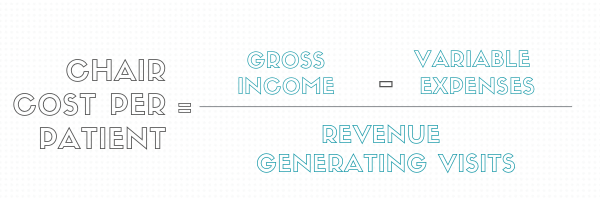Quick Tip: How to Calculate Patient Chair Cost
Chair cost represents the overhead expenses associated with providing care to each patient.
Looking at your chair cost involves a few different things, including looking into the insurance your practice accepts and your fixed costs. It can be a little complicated, but the bottom line is to compare you chair cost to your insurance reimbursement to make sure that you're making enough money to cover your chair cost.
If you don't already know your chair cost, keep reading to follow a simple formula and figure out if you're making enough revenue to scale your optometry practice.
An Example of How to Calculate Your Practice's Chair Cost

Since there are a few steps involved, let's take a look at an example.
 Step 1. Calculate your fixed costs (gross income - variable expenses).
Step 1. Calculate your fixed costs (gross income - variable expenses).
Assume that your practice's operating expenses are 45% of your gross income.
$400,000 (gross income) - $180,000 (variable expenses) = $220,000 (fixed costs)
Step 2. Find your revenue generating patient visits per year. Follow up appointments, prescription refill requests, and other miscellaneous visits generally do not bring in revenue. To calculate chair costs, do not include these visits. Only count those that result in revenue earned.
Revenue generating visits = 4,000
Step 3. Calculate your chair cost.
$220,000 (fixed costs) / 4,000 (revenue generating visits) = $55 (chair cost)
At a chair cost of $55 per patient, we can deduce that if you accept a vision plan that pays less than $55 for the exam, you're losing money on that patient.
If you realize that your reimbursements are lower than your chair cost and you're losing money on a patient, there are two approaches you can take towards fixing it. You can still take on a patient with a low paying plan and try to make up the loss with volume. Additional revenue can still be made with more frame sales. But, if you do not make enough additional revenue it could be taking time away from being more productive in other parts of your practice. So exercise with caution.
We have 7 other important benchmark formulas you should be calculating.
Download the formulas today in our free ebook!

